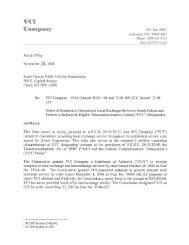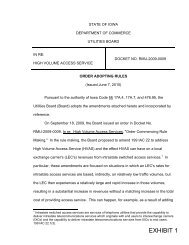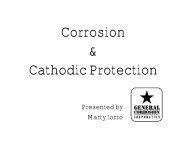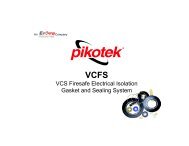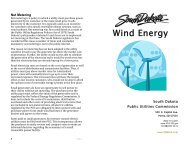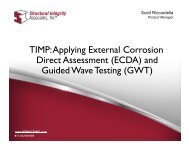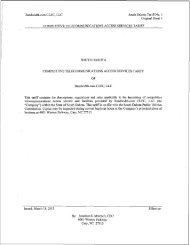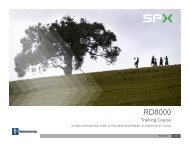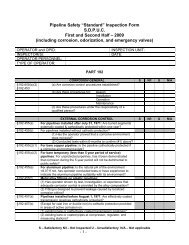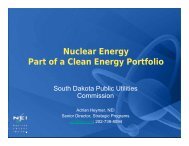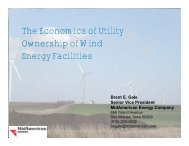pipeline safety records inspection checklist - South Dakota Public ...
pipeline safety records inspection checklist - South Dakota Public ...
pipeline safety records inspection checklist - South Dakota Public ...
You also want an ePaper? Increase the reach of your titles
YUMPU automatically turns print PDFs into web optimized ePapers that Google loves.
I. GENERAL INFORMATION<br />
Operator Evaluated<br />
Operator IOCS ID<br />
Inspection Unit IOCS ID<br />
Unit Description<br />
Portions of Unit<br />
Inspected<br />
Contact Person / Title<br />
(person interviewed)<br />
PIPELINE SAFETY RECORDS INSPECTION CHECKLIST<br />
2010<br />
<strong>South</strong> <strong>Dakota</strong> <strong>Public</strong> Utilities Commission<br />
CY-10 - 1 –<br />
Phone Number<br />
Responsible Party/Title Phone Number<br />
Mailing Address<br />
Inspection Date Last Inspection Date<br />
Location of Inspection<br />
Inspector Name<br />
II. PART 191 – REPORTING REQUIREMENTS S N/I U N/A<br />
§191.5<br />
Have any incident(s) occurred within the last 2 calendar years (yes<br />
or no)?<br />
Were incident(s) telephonically reported to NRC? (1-800-424-8802)<br />
Info Date Name of Location Time of # of Comments<br />
required to<br />
be<br />
reported<br />
by<br />
telephone:<br />
reported<br />
to NRC<br />
person<br />
reporting<br />
incident fatalities/<br />
injuries<br />
§191.9 and §191.15<br />
Was all required information reported to NRC?<br />
Are incidents reported by telephone followed up with a 30-day<br />
written report? (RSPA Form 7100.1) – Distribution or (RSPA Form 7100.2)<br />
– Transmission and Gathering<br />
Type of form<br />
submitted to<br />
PHMSA<br />
Date submitted<br />
to PHMSA<br />
Copy available<br />
in facility’s<br />
<strong>records</strong><br />
Form is filled<br />
out with all<br />
required info<br />
S – Satisfactory N/I – Not Inspected U – Unsatisfactory N/A – Not applicable
II. PART 191 – REPORTING REQUIREMENTS S N/I U N/A<br />
§191.11; §191.17;<br />
and<br />
ARSD 20:10:37:10<br />
§191.23<br />
Was additional relevant information submitted as a supplementary<br />
report (if necessary)?<br />
Are annual reports submitted to Washington and the SDPUC?<br />
(RSPA Form 7100.1-1) – Distribution Systems or (RSPA Form 7100.2-1) –<br />
Transmission and Gathering Systems<br />
Type of form<br />
submitted to<br />
PHMSA<br />
Date most<br />
recent<br />
submitted to<br />
PHMSA<br />
CY-10 - 2 –<br />
Copy available<br />
in facility’s<br />
<strong>records</strong><br />
Form is filled<br />
out with all<br />
required info<br />
Does the facility have a procedure for reporting <strong>safety</strong> related<br />
conditions?<br />
(a) Did any of the following <strong>safety</strong> related conditions occur within the<br />
last 2 calendar years:<br />
General corrosion that reduced wall thickness to less than<br />
required for the MAOP or localized corrosion pitting where<br />
leaks may occur (for <strong>pipeline</strong>s operating at 20% or more of<br />
SMYS, i.e. transmission lines)<br />
Unintended movement or abnormal loading by<br />
environmental causes that impairs the serviceability of the<br />
<strong>pipeline</strong><br />
Any crack or other material defect that impairs the structural<br />
integrity of a LNG facility that contains controls or process<br />
gas or LNG<br />
Any material defect or physical damage that impairs the<br />
serviceability of <strong>pipeline</strong>s that operate at 20% or more of<br />
SMYS (transmission lines)<br />
Any malfunction or operating error that causes the MAOP<br />
to be exceeded (plus the allowed build up for pressure<br />
limiting devices)<br />
A leak in a <strong>pipeline</strong> that constitutes an emergency<br />
Inner tank leakage, ineffective insulation, or frost heave that<br />
impairs the structural integrity of a LNG storage tank<br />
Any <strong>safety</strong>-related condition that could lead to an<br />
imminent hazard and causes a reduction in operating<br />
pressure (by 20% or more) or shutdown of a <strong>pipeline</strong><br />
§191.23(b) NOTE: reports are not required for: 1) master meter systems or<br />
customer-owned service lines; 2) incidents or conditions that result<br />
in an incident before the deadline for filing the report; 3) <strong>pipeline</strong>s<br />
that are more than 220 yards from occupied buildings or outdoor<br />
places of assembly (except they are required in railroad and road<br />
ROWs); and 4) if the condition is corrected by repair or replacement<br />
before the deadline for filing the report (except they are required for<br />
general corrosion conditions)<br />
§191.25 (a) Was a report filed within five (5) working days of determination<br />
and within ten (10) working days of discovery for each <strong>safety</strong>-related<br />
Safety-related<br />
condition discovered<br />
condition?<br />
Discovery date Determination<br />
date<br />
Date reported<br />
to PHMSA<br />
Was all required information included in the “Safety-Related<br />
Condition Report” (refer to 191.25(b))?<br />
Copy included<br />
in facility’s<br />
<strong>records</strong><br />
S – Satisfactory N/I – Not Inspected U – Unsatisfactory N/A – Not applicable<br />
X<br />
X
III. PART 192 – OPERATION & MAINTENANCE PLANS S N/I U N/A<br />
§192.605(a)<br />
Is the plan reviewed and updated at intervals not exceeding 15<br />
months but at least once each calendar year?<br />
Date of most current Date of previous Signatory<br />
review & update review & update<br />
List sections of manual that have been significantly updated (i.e.<br />
additions/deletions) in the last 2 calendar years:<br />
§192.605(a) Are appropriate parts of the manual kept at locations where<br />
operations and maintenance activities are conducted?<br />
List locations:<br />
§192.605(b)(3) Are construction <strong>records</strong>, maps, & operating history available to<br />
appropriate operating personnel?<br />
List locations where and how these <strong>records</strong> are made available:<br />
§192.605(b)(8)<br />
List operating personnel that have access to these <strong>records</strong>:<br />
Does the facility periodically review the work done by operator<br />
personnel to determine the effectiveness, and adequacy of<br />
procedures used in normal operations and maintenance and modify<br />
the procedures when deficiencies are found?<br />
Review date Type of review Personnel<br />
reviewed<br />
CY-10 - 3 –<br />
Documented in<br />
<strong>records</strong><br />
IV. PART 192 – EMERGENCY PLANS S N/I U N/A<br />
§192.615<br />
Does the operator have a written emergency plan?<br />
§192.605(e)<br />
Date of most current Date of previous Signatory<br />
review & update review & update<br />
Has the operator made provisions for:<br />
§192.615(b)(1) (a) Furnishing applicable portions of the emergency plan to<br />
supervisory personnel who are responsible for emergency<br />
action?<br />
List of Persons Plan Furnished To:<br />
§192.615(b)(2) (b) Training appropriate employees as to the requirements of<br />
the emergency plan.<br />
Training Date Persons Trained Comments<br />
§192.615(b)(3) (c) Review activities following actual or simulated emergencies<br />
to determine if they are effective. Does facility have the<br />
review and its outcome documented within their <strong>records</strong>?<br />
S – Satisfactory N/I – Not Inspected U – Unsatisfactory N/A – Not applicable
IV. PART 192 – EMERGENCY PLANS S N/I U N/A<br />
§192.615(c)<br />
Establish mutual liaison with fire, police, and other public officials,<br />
such that each is aware of the others resources and capabilities in<br />
GPTC guidance dealing with gas emergencies.<br />
material<br />
Does the facility have the following information compiled for each<br />
applicable government organization:<br />
- Name<br />
- Type of organization<br />
- Geographic area covered<br />
- Availability to assist in case of a <strong>pipeline</strong> emergency<br />
- Responsibility and resources for fire, bodily injury, control,<br />
and area evacuation problems in connection with a gas<br />
<strong>pipeline</strong> emergency<br />
- Type, size, and capacity of equipment and vehicles<br />
- Procedures to facilitate prompt communications in<br />
emergencies<br />
- Level of training of responders<br />
Does facility maintain documentation that shows they supplied the<br />
appropriate government organization with the following information:<br />
- Availability, capability, and location of:<br />
Facility personnel (the list should include<br />
appropriate employees who can be contacted at<br />
any hour);<br />
Facility equipment; and<br />
Facility materials for response to emergencies.<br />
V. PART 192 – TEST REQUIREMENTS FOR PIPELINES S N/I U N/A<br />
§192.503 Have any new segments of <strong>pipeline</strong> been installed or segments of<br />
relocated or replaced <strong>pipeline</strong> been returned to service (yes or no)?<br />
§192.503(d) Is each non-welded joint used to tie in a test segment leak tested at<br />
not less than its operating pressure? (yes or no)<br />
192.505 & 192.517 For steel <strong>pipeline</strong>s to be operated at a hoop stress of 30<br />
percent or more of SMYS (i.e. transmission facilities):<br />
Are pressure test <strong>records</strong> maintained that contain the following<br />
information (these <strong>records</strong> must be maintained for the life of the<br />
<strong>pipeline</strong>):<br />
- Operator’s name<br />
- Name of operator’s employee responsible for making the test<br />
- Name of any test company used (if applicable)<br />
- Pipeline segment’s MAOP<br />
- Test medium used (medium must be liquid, air, natural gas, or inert<br />
gas that is compatible with material, free of sediments, and<br />
nonflammable)<br />
- Test pressure<br />
- Test duration<br />
- Pressure recording charts, or other record of pressure readings<br />
- Elevation variations, whenever significant for the particular test<br />
- Leaks and failures noted and their disposition (each potentially<br />
hazardous leak must be located and eliminated)<br />
192.505(a) Note: in class 1 or 2 locations if there is a building intended for<br />
human occupancy within 300 ft, a hydrostatic test must be<br />
conducted to a test pressure of at least 125% of MOP. If the<br />
buildings are evacuated while hoop stress exceeds 50% of SMYS<br />
then air or gas may be used as a test medium.<br />
CY-10 - 4 –<br />
S – Satisfactory N/I – Not Inspected U – Unsatisfactory N/A – Not applicable
V. PART 192 – TEST REQUIREMENTS FOR PIPELINES S N/I U N/A<br />
§192.505(b) Have any compressor, regulator, or measuring stations been newly<br />
installed or replaced in Class 1 and Class 2 locations? (yes or no)<br />
If yes, were they tested to at least Class 3 location requirements?<br />
§192.505(c) Is the pressure at or above test pressure for at least eight hours?<br />
§192.505(d)<br />
§192.505(d)(1)<br />
§192.505(d)(2)<br />
§192.505(d)(3)<br />
(yes or no)<br />
If only components were added or replaced (not pipe) and not<br />
pressure tested:<br />
Does facility have manufacturer certification of at least one of the<br />
following:<br />
- component was tested to the pressure required for the<br />
<strong>pipeline</strong> to which it is being added;<br />
- component was manufactured under a quality control<br />
system that ensures each item is at least equal in strength<br />
to a prototype and the prototype was tested to a test<br />
pressure required for the <strong>pipeline</strong> to which it is being added;<br />
or<br />
- component carries a pressure rating established through<br />
applicable ASME/ANSI, MSS specifications, or by unit<br />
strength calculations as described in §192.143.<br />
List or highlight which certification the facility has within its <strong>records</strong>.<br />
§192.505(e) Were any fabricated or short sections of pipe installed? (yes or no)<br />
192.507 and 192.517<br />
§192.507(b)(1)<br />
§192.507(b)(2)<br />
If yes were these sections pressure tested for at least four hours<br />
before they are installed, if it is impractical to pressure test after<br />
installation? (yes or no)<br />
For <strong>pipeline</strong>s to be operated at a hoop stress less than 30<br />
percent SMYS and at or above 100 psig.<br />
Are pressure test <strong>records</strong> maintained that contain the following<br />
information (these <strong>records</strong> must be maintained for the life of the<br />
<strong>pipeline</strong>):<br />
- Operator’s name<br />
- Name of operator’s employee responsible for making the test<br />
- Name of any test company used (if applicable)<br />
- Pipeline segment’s MAOP<br />
- Test medium used (medium must be liquid, air, natural gas, or inert<br />
gas that is compatible with material, free of sediments, and<br />
nonflammable)<br />
- Test pressure<br />
- Test duration<br />
- Pressure recording charts, or other record of pressure readings<br />
- Elevation variations, whenever significant for the particular test<br />
- Leaks and failures noted and their disposition (each potentially<br />
hazardous leak must be located and eliminated)<br />
If the segment is stressed to 20 percent or more of SMYS and is<br />
using natural gas, inert gas, or air is one of the following used:<br />
- A leak test at a pressure between 100 psig and the pressure<br />
required to produce a hoop stress of 20 percent of SMYS;<br />
or<br />
- The line is walked to check for leaks while the hoop stress is held<br />
at approximately 20 percent of SMYS<br />
List or highlight the one used.<br />
CY-10 - 5 –<br />
S – Satisfactory N/I – Not Inspected U – Unsatisfactory N/A – Not applicable
V. PART 192 – TEST REQUIREMENTS FOR PIPELINES S N/I U N/A<br />
§192.507(c) Is the pressure maintained at or above the test pressure for at least<br />
192.509 and 192.517<br />
GPTC Guidance<br />
Material<br />
one hour? (yes or no)<br />
For <strong>pipeline</strong>s (except plastic and service) to operate below 100<br />
psig.<br />
Are pressure test <strong>records</strong> maintained that contain the following<br />
information (these <strong>records</strong> must be maintained for at least 5 years):<br />
- Date<br />
- Location of test<br />
- Test pressure applied<br />
- Test duration<br />
§192.509(b) Is each main that is to be operated at less than 1 psig tested to at<br />
least 10 psig? (yes or no)<br />
§192.509(b) Is each main that is to be operated at or above 1 psig tested to at<br />
192.511 and 192.517<br />
GPTC Guidance<br />
Material<br />
least 90 psig? (yes or no)<br />
For non-plastic service lines.<br />
Are pressure test <strong>records</strong> maintained that contain the following<br />
information (these <strong>records</strong> must be maintained for at least 5 years):<br />
- Date<br />
- Location of test<br />
- Test pressure applied<br />
- Test duration<br />
§192.511(a) If feasible, is the connection to the main included in the test? (yes or<br />
no)<br />
§192.511(b) Are service lines expected to operate at a pressure of at least 1 psig<br />
but not more than 40 psig tested at a pressure of not less than 50<br />
psig? (yes or no)<br />
§192.511(c) Are service lines expected to operate at a pressure of more than 40<br />
psig tested at a pressure of not less than 90 psig? (yes or no)<br />
§192.511(c) Are steel service lines stressed to 20% or more of SMYS tested in<br />
192.513 and 192.517<br />
GPTC Guidance<br />
Material<br />
accordance with §192.507?<br />
For plastic <strong>pipeline</strong>s.<br />
Are pressure test <strong>records</strong> maintained that contain the following<br />
information (these <strong>records</strong> must be maintained for at least 5 years):<br />
- Date<br />
- Location of test<br />
- Test pressure applied<br />
- Test duration<br />
§192.513(a) Is each segment of a plastic <strong>pipeline</strong> tested in accordance with this<br />
section? (yes or no)<br />
§192.513(c) Does the operator test to at least 150% of the maximum operating<br />
pressure or 50 psig whichever is greater? (yes or no and list out<br />
which one is greater for each operator)<br />
§192.513(d) During the test, is the temperature of the pipe not more than 100ºF,<br />
or the temperature at which the long term hydrostatic strength has<br />
been determined, whichever is greater? (yes or no and list out which<br />
one is greater for each operator)<br />
VI. PART 192 – FIELD REPAIRS: TRANSMISSION LINES S N/I U N/A<br />
192.709(a)<br />
Are field repair <strong>records</strong> (for the pipe) maintained that contain the<br />
following information (these <strong>records</strong> must be maintained for the life<br />
of the <strong>pipeline</strong>):<br />
- Date<br />
- Location of repair<br />
CY-10 - 6 –<br />
S – Satisfactory N/I – Not Inspected U – Unsatisfactory N/A – Not applicable
VI. PART 192 – FIELD REPAIRS: TRANSMISSION LINES<br />
- Description of each repair made (including pipe-to-pipe<br />
connections)<br />
S N/I U N/A<br />
192.709(b)<br />
Are field repair <strong>records</strong> (for parts of the system other than the pipe)<br />
maintained that contain the following information (these <strong>records</strong><br />
must be maintained for at least 5 years):<br />
- Date<br />
- Location of repair<br />
- Description of each repair made<br />
192.709(c) Note: Repairs generated by patrols, surveys, <strong>inspection</strong>s, or tests<br />
required by subparts L and M of this part must be retained for at<br />
least 5 years or until the next patrol, survey, <strong>inspection</strong>, or test is<br />
completed (whichever is longer).<br />
Testing of repairs<br />
§192.719(a) Were any segments of pipe replaced within the system? (yes or no)<br />
If yes, was the replacement pipe tested to the requirement of a new<br />
line installed in the same location and <strong>records</strong> maintained as<br />
required under Subpart J Testing Requirements? (Note: the pipe<br />
may be tested before it is installed)<br />
VII. PART 192 – TEST REQUIREMENTS FOR REINSTATING SERVICE<br />
LINES<br />
§192.725(a) Does the operator test reinstated service lines in the same manner<br />
as new lines and maintain <strong>records</strong> as required by Subpart J?<br />
§192.725(b) Is each service line that is temporarily disconnected tested from the<br />
point of disconnection and <strong>records</strong> maintained as required by<br />
Subpart J?<br />
CY-10 - 7 –<br />
S – Satisfactory N/I – Not Inspected U – Unsatisfactory N/A – Not applicable<br />
S N/I U N/A<br />
VII. PART 192 – WELDING S N/I U N/A<br />
General<br />
§192.225(a) Is welding performed by a qualified welder in accordance with API<br />
1104, section IX of the ASME Boiler and Pressure Vessel Code, or<br />
Appendix C of Part 192? (yes or no)<br />
API 1104<br />
If yes, highlight or specify which method is used.<br />
If using API 1104, does operator maintain <strong>records</strong> of qualified<br />
welders that contains the following information (it is recommended<br />
they use Figure 2 from API 1104):<br />
- Date of welding<br />
- Location<br />
- Name of welder<br />
- Weld position<br />
- Welding time<br />
- Weather conditions<br />
- Voltage<br />
- Amperage<br />
- Welding machine type<br />
- Welding machine size<br />
- Filler metal<br />
- Reinforcement size<br />
- Pipe type and grade<br />
- Wall thickness<br />
- Outside diameter
VII. PART 192 – WELDING<br />
- Tensile strength information (and any remarks on tensile strength<br />
test)<br />
- Bend test information (and any remarks on bend test)<br />
- Nick-break test information (and any remarks on nick-break test)<br />
- Date tested<br />
- Location of test<br />
- Name of tester<br />
- Results of qualification test (whether they are qualified or<br />
disqualified)<br />
S N/I U N/A<br />
§192.225(b).<br />
Has each welding procedure been recorded in detail, including the<br />
results of the qualifying tests?<br />
If using API 1104, does the record include the items in Appendix A<br />
of this form?<br />
If using ASME Boiler and Pressure Vessel code, does the record<br />
include the items in Appendix B of this form?<br />
Did the procedures pass all the tests?<br />
Does the data on the record conform to the requirements of the<br />
welding standard used (1104 or Boiler and Pressure Vessel)?<br />
§192.229(b) Does operator maintain <strong>records</strong> for each qualified welder that show<br />
the welder has engaged in a specific welding process (for welders<br />
that qualify under 192.227(a)?<br />
192.229(c)<br />
(1) For <strong>pipeline</strong>s operating at a pressure that produces a hoop stress<br />
of 20% or more of SMYS, does the operator have <strong>records</strong> that show<br />
within the preceding 6 months the welder has had one weld tested<br />
and found acceptable under section 6 or 9 of API Standard 1104,<br />
Exception: A welder qualified under an earlier addition may<br />
weld but not requalify under that earlier addition.<br />
Alternatively, do welders maintain an ongoing qualification status by<br />
performing welds tested and found acceptable under section 6 or 9<br />
of API 1104 at least twice each calendar year, but at intervals not<br />
exceeding 7-1/2 months?<br />
(2) May not weld on pipe to be operated at a pressure less than 20<br />
percent of SMYS unless the welder is tested in accordance with<br />
§192.229(c)(1) or requalifies under §192.229(d)(1) or (d)(2).<br />
192.229(d) For welders that qualify under 192.227(b), does operator maintain<br />
<strong>records</strong> for each qualified welder that show the welder has been<br />
requalified within preceding 15 calendar months or within the<br />
preceding 7 ½ calendar months (at least twice a year) had one of<br />
the following :<br />
- a production weld cut out, tested, and found acceptable with<br />
the qualifying test; or<br />
- for welders that work only on service lines 2 inches or<br />
smaller, two sample welds tested and found acceptable in<br />
accordance with section III of Appendix C<br />
§192.243(d) When nondestructive testing is required under §192.241(b), are the<br />
following percentages of each day's field butt welds, selected at<br />
random by the operator, nondestructively tested over their entire<br />
circumference?<br />
§192.243(d) (1) In Class 1 locations, except offshore, at least 10 percent<br />
§192.243(d) (2) In Class 2 locations, at least 15 percent.<br />
CY-10 - 8 –<br />
S – Satisfactory N/I – Not Inspected U – Unsatisfactory N/A – Not applicable
VII. PART 192 – WELDING S N/I U N/A<br />
§192.243(d) (3) In Class 3 and Class 4 locations, at crossings of major or navigable<br />
rivers, offshore, and within railroad or public highway rights-of-way,<br />
including tunnels, bridges, and overhead road crossings, 100<br />
percent unless impracticable, in which case at least 90 percent.<br />
Nondestructive testing must be impracticable for each girth weld not<br />
tested.<br />
§192.243(f) Are <strong>records</strong> showing by milepost, engineering station, or geographic<br />
feature, the number of girth welds made, the number tested, the<br />
number rejected, and the disposition of the rejects retained for the<br />
life of the <strong>pipeline</strong>?<br />
VIII. PART 192 – REPAIR OR REMOVAL OF WELD DEFECTS S N/I U N/A<br />
§192.245 The operator’s procedures should be inspected in the field to<br />
determine if they are being followed.<br />
IX. PART 192 – JOINING OF PIPELINE MATERIALS OTHER THAN BY<br />
WELDING<br />
What types of joining does the operator perform (i.e. plastic fusion,<br />
mechanical joints, electrofusion)?<br />
192.283<br />
192.285(a)(1)<br />
192.285(a)(2) and<br />
192.285(c)<br />
List out all types of joining used.<br />
Does operator have written procedures for each type of joint<br />
available for review? (yes or no)<br />
Do these procedures follow what is required by the manufacturer?<br />
Has the operator changed any parameters? (yes or no)<br />
Does operator have copies of the destructive tests used to qualify<br />
the joining procedures? (yes or no)<br />
Does operator have copies of employee training dates and type of<br />
join training for each employee? (yes or no)<br />
Does operator have copies of employee making specimen joints<br />
from pipe sections joined according to the procedure that passes<br />
<strong>inspection</strong> and test as set forth in 192.285(b)?<br />
Does the operator maintain <strong>records</strong> of each employee’s<br />
requalification? (yes or no)<br />
Is the requalification done as required and documented within their<br />
<strong>records</strong> (if employees do not make a joint during a 12 month period<br />
or if 3 joints or 3%, whichever is greater, are found unacceptable<br />
then they must be requalified)? (yes or no)<br />
Note: be sure to see if operator has applied for and obtained a<br />
waiver on this issue and make sure they are following the waiver<br />
requirements.<br />
192.287 Is each person that inspects joints in plastic pipe qualified by<br />
appropriate training or experience in evaluating the acceptability of<br />
plastic pipe joints?<br />
CY-10 - 9 –<br />
S – Satisfactory N/I – Not Inspected U – Unsatisfactory N/A – Not applicable<br />
S N/I U N/A<br />
X. PART 192 – INSPECTION & REPAIR OF MATERIALS S N/I U N/A<br />
§192.307 The operator’s procedures should be inspected in the field to<br />
determine if they are being followed.
XI. PART 192 – ABNORMAL OPERATIONS: TRANSMISSION LINES S N/I U N/A<br />
§192.605(c) Has the operator had any occurrences of the following conditions in<br />
the last 2 years (yes or no):<br />
- Unintended closure of valves or shutdowns<br />
- An increase or decrease in pressure or flow rate outside of normal<br />
operating limits<br />
- Loss of communications<br />
- The operation of any <strong>safety</strong> device<br />
- Any other malfunction of a component<br />
- Any deviation from normal operation<br />
- Any other foreseeable malfunction of a component, deviation from<br />
normal operation, or personnel error<br />
List out what type and date of occurrence.<br />
§192.605(c)(4) If abnormal operation occurred, did operator review personnel<br />
response considering the actions taken, whether procedures were<br />
followed, and whether procedures were adequate or should be<br />
revised? Was this review documented?<br />
XII. PART 192 – SURVEILLANCE S N/I U N/A<br />
§192.613(a) Has the operator conducted continuing surveillance to determine if<br />
the following issues need to be addressed:<br />
- Change in class location<br />
- Failures<br />
- Leakage history<br />
- Corrosion<br />
- Cathodic protection<br />
- Other unusual conditions<br />
If yes, provide explanation of issues operator feels need to be<br />
addressed.<br />
GPTC Guidance Does the operator review and analyze the following <strong>records</strong> for its<br />
continuing surveillance procedures:<br />
- Patrols<br />
- Leakage surveys<br />
- Valve <strong>inspection</strong>s<br />
- Vault <strong>inspection</strong>s<br />
- Pressure regulating, relieving, and limiting equipment<br />
<strong>inspection</strong>s<br />
- Corrosion control <strong>inspection</strong>s<br />
- Facility failure investigations<br />
Was this review documented?<br />
§192.613(b) Has the operator documented and initiated a program to correct<br />
problems discovered?<br />
XIII. PART 192 – DAMAGE PREVENTION S N/I U N/A<br />
§192.614 Does the operator have a list of persons/companies that engage in<br />
excavating? (yes or no)<br />
GPTC Guidance Does this list get periodically reviewed and updated? If yes, provide<br />
the most current update and the intervals at which review is<br />
performed.<br />
Does operator notify the public and excavators of its damage<br />
prevention program? If yes, review the most current notification and<br />
provide info on how often this notification is updated and sent out.<br />
Review <strong>records</strong> of pending excavation notifications. Do the <strong>records</strong><br />
contain the following information:<br />
CY-10 - 10 –<br />
S – Satisfactory N/I – Not Inspected U – Unsatisfactory N/A – Not applicable
XIII. PART 192 – DAMAGE PREVENTION S N/I U N/A<br />
- Name of person giving notification<br />
- Name of entity which will be conducting excavation activities<br />
- Telephone number for contacting the entity<br />
- Location of the planned excavation activities<br />
- Date and time of commencement of excavation activities<br />
- Type and scope of excavation activities<br />
192.617<br />
Highlight or give explanation of missing information.<br />
Excavation notification response. Does the operator document their<br />
response to the excavation notification prior to the start of the<br />
excavation activity? If yes, provide list of information that is<br />
documented.<br />
Does operator maintain <strong>records</strong> of accidents and failures and their<br />
causes?<br />
Has operator addressed the causes of failure to minimize the<br />
possibility of recurrence?<br />
Do the operator’s and operator’s contractors drilling/boring<br />
procedures include actions to protect their facilities from the dangers<br />
posed by drilling and other trenchless technologies?<br />
Did the operator follow its written procedures pertaining to<br />
notification of excavation, marking, positive response and the use of<br />
the one call system?<br />
What is the operator’s number of <strong>pipeline</strong> damages per 1,000 locate<br />
requests?<br />
XIV. PART 192 – PUBLIC EDUCATION S N/I U N/A<br />
Procedures for §192.616 – This information is covered in a separate<br />
<strong>inspection</strong> <strong>checklist</strong>.<br />
XV. PART 192 – FAILURE INVESTIGATION S N/I U N/A<br />
§192.617 Have any accidents or failures occurred within the past 2 years? If<br />
yes, give explanation.<br />
If yes, was the accident and/or failure analyzed to determine the<br />
cause and steps taken to minimize a recurrence?<br />
Was the analysis documented?<br />
XVI. PART 192 – MAXIMUM ALLOWABLE OPERATING PRESSURE S N/I U N/A<br />
§192.619/.621<br />
§192.623<br />
Is the MAOP commensurate with the class location?<br />
(Spot check calculations)<br />
How was the MAOP determined?<br />
(a) By design and test?<br />
(b) By highest operating pressure to which the segment of<br />
line was subjected between July 1, 1965 and July 1,<br />
1970.<br />
Were MAOP’s determined correctly?<br />
SYSTEM Initial<br />
Operation<br />
Month/yr.<br />
CY-10 - 11 –<br />
Highest<br />
Pressure<br />
Test<br />
Highest<br />
Operating<br />
Pressure<br />
S – Satisfactory N/I – Not Inspected U – Unsatisfactory N/A – Not applicable<br />
MAOP Limiting<br />
Basis<br />
NOTES:<br />
§192.505 Strength test requirements for steel <strong>pipeline</strong> to operate at a hoop stress of 30 percent or more of SMYS.<br />
§192.507 Test requirements for steel <strong>pipeline</strong> to operate at a hoop stress less than 30 percent or more of SMYS and<br />
at or above 100 psig.<br />
§192.509 Test requirements for <strong>pipeline</strong>s to operate below 1000 psig.
XVII. PART 192 – PRESSURE LIMITING AND REGULATING STATIONS S N/I U N/A<br />
§192.739(a)<br />
Does the operator perform and document <strong>inspection</strong>s on pressure<br />
limiting relief devices and pressure regulators not to exceed 15<br />
months, but at least annually to determine the following:<br />
In good mechanical condition?<br />
Adequate from the standpoint of capacity and reliability of<br />
operation for the service in which it is employed?<br />
Set to control or relieve at the correct pressures consistent<br />
with the pressure limits of §192.201(a)? (See exception in<br />
§192.739(b))<br />
(d) Properly installed and protected from dirt, liquids or<br />
other conditions that might prevent proper operation?<br />
§192.739(b)<br />
Does the operator have any steel <strong>pipeline</strong>s whose MAOP is<br />
determined under §192.619(c)? If yes, the following control or relief<br />
pressures apply and inspector should double check operator<br />
calculations.<br />
If the MAOP is 60 PSI gage or more, the control or relief pressure<br />
limit is as follows:<br />
If the MAOP produces a hoopstress of:<br />
1) 72 percent or greater then the pressure limit is the MAOP<br />
plus 4 percent.<br />
2) Unknown as a percentage of SMYS, then the pressure limit is<br />
a pressure that will prevent unsafe operation of the <strong>pipeline</strong><br />
considering its operating and maintenance history and<br />
MAOP.<br />
§192.743 Does the operator perform and document <strong>inspection</strong>s on relief<br />
devices not to exceed 15 months but at least once each calendar<br />
year to determine the following?<br />
(a) Has sufficient capacity been determined by testing in<br />
place or by review and calculations?<br />
(b) Are calculations used to determine capacity available?<br />
(c) Required that unsatisfactory conditions be corrected in<br />
an appropriate time frame?<br />
XVIII. PART 192 – TELEMETERING OR RECORDING GAUGES-<br />
DISTRIBUTION<br />
§192.741(a) Does the operator have telemetering or pressure recording gauges<br />
to indicate gas pressure in the district that is supplied by more than<br />
one district pressure regulating station? (yes or no)<br />
§192.741(b) Has the operator determined if telemetering or pressure recording<br />
gauges are needed for a distribution system supplied by only one<br />
district pressure regulating station? (yes or no)<br />
§192.741(c)<br />
Does the operator inspect equipment and take corrective measures<br />
when there are indications of abnormally high or low pressure? (yes<br />
or no)<br />
Are these <strong>inspection</strong>s documented within the operator’s <strong>records</strong>?<br />
(yes or no)<br />
CY-10 - 12 –<br />
S – Satisfactory N/I – Not Inspected U – Unsatisfactory N/A – Not applicable<br />
S N/I U N/A
XVIII. PART 192 – TELEMETERING OR RECORDING GAUGES-<br />
DISTRIBUTION<br />
GPTC Guidance Are pressure charts of telemetering equipment maintained with the<br />
following information:<br />
- Name of operator<br />
- Location of recording gauge-station name or number or both<br />
- Date and time of recorded pressure readings<br />
- Any tests performed on the gauge during the recorded<br />
period<br />
CY-10 - 13 –<br />
S – Satisfactory N/I – Not Inspected U – Unsatisfactory N/A – Not applicable<br />
S N/I U N/A<br />
XIX. PART 192 – PREVENTION OF ACCIDENTAL IGNITION S N/I U N/A<br />
§192.751 The operator’s procedures should be inspected in the field to<br />
determine if they are being followed.<br />
XX. PART 192 – CONSTRUCTION PRACTICES S N/I U N/A<br />
§192.313 Bends and Elbows (the operator’s procedures should be inspected<br />
in the field to determine if they are being followed)<br />
§192.315 Wrinkle Bends in Steel Pipe (the operator’s procedures should be<br />
inspected in the field to determine if they are being followed)<br />
§192.317 Protection from Hazards (the operator’s procedures should be<br />
inspected in the field to determine if they are being followed)<br />
§192.319 Installation of Pipe in Ditch (the operator’s procedures should be<br />
inspected in the field to determine if they are being followed)<br />
§192.321 Installation of Plastic Pipe (the operator’s procedures should be<br />
inspected in the field to determine if they are being followed)<br />
§192.323 Casing (the operator’s procedures should be inspected in the field<br />
to determine if they are being followed)<br />
§192.325 Underground Clearance (the operator’s procedures should be<br />
inspected in the field to determine if they are being followed)<br />
§192.327 Cover (the operator’s procedures should be inspected in the field to<br />
determine if they are being followed)
4 API STANDARD 1 104<br />
Reference: API Standard 1104,5.2<br />
PROCEDURE SPECIFICATION NO.<br />
1 For Welding of Pipe and fittings I<br />
( Process I<br />
Material<br />
Diameter and wall thickness<br />
Joint design<br />
Filler metal and no. of beads<br />
Electrical or flame characteristics<br />
Position<br />
Direction of welding<br />
No. of welders<br />
Time lapse between passes<br />
Type and removal of lineup clamp<br />
Cleaning and/or grinding<br />
Preheatlstress relief<br />
Shielding gas and flow rate<br />
Shielding flux<br />
Speed of travel<br />
Plasma gas composition Plasma gas flow rate<br />
Plasma gas orifice size<br />
Sketches and tabulations attached<br />
Tested Welder<br />
Approved Welding supervisor<br />
Adopted Chief engineer<br />
Approximately 1/16'' (1.6 mm)<br />
I<br />
Standard V-Bevel Butt Joint<br />
l/32" - '116'' (0.8 - 1.6 mm)<br />
Approximately 1/13'<br />
(3 mm)<br />
I Sequence of Beads I<br />
Note: Dimensions are for example only.<br />
Bead Number<br />
Copyright Amencan Petmleum lnstnule<br />
Pmvlded by IHS under license wlh Apt<br />
NO reproduction or nelwrkmg permtlted wlthwl lhcenrs fmm IHS<br />
ELECTRODE SIZE AND NUMBER OF BEADS<br />
I Electrode - -<br />
Size and<br />
Type<br />
1<br />
Voltage<br />
I Amperage<br />
and<br />
Polarity<br />
I<br />
Speed<br />
Figure l-Sample Procedure Specification Form<br />
Not for Resale
COUPON TEST REPORT<br />
I Date Test No. 1<br />
Location<br />
State Weld Position: Roll Fixed 0<br />
Welder Mark<br />
Welding time Time of day<br />
Mean temperature Wind break used<br />
Weather conditions<br />
Voltage Amperage<br />
Welding machine type Welding machine size<br />
Filler metal<br />
Reinforcement size<br />
Pipe type and grade<br />
Wall thickness Outside diameter<br />
Tensile strength<br />
Fracture location<br />
Procedure Qualifying test 0 Qualified<br />
0 Welder 0 Line test 0 Disqualified<br />
Maximum tensile Minimum tensile Average tensile<br />
Remarks on tensile-strength tests<br />
1.<br />
2.<br />
1 ::<br />
Remarks on bend tests<br />
1.<br />
2.<br />
3.<br />
4.<br />
Remarks on nick-break tests<br />
Test made at Date<br />
Tested by Supervised by<br />
Note: Use back for additional remarks. This form can be used to report either a procedure qualification test or a welder qualification test.<br />
Copyrtghl Amer~ran Petroleum lnstllule<br />
Pmvldsd by IHS under llcense wllh API<br />
No repdoduct~on or nswhmg perm~lted wtthwt lhmnse from IHS<br />
Figure 2-Sample Coupon Test Report<br />
Not for Resale
4pp.m dj'w 8<br />
2007 SECTION IX<br />
OW-482 SUGGESTED FORMAT FOR WELDING PROCEDURE SPECIFICATIONS (WPS)<br />
(See OW-200.1, Section IX, ASME Boiler and Pressure Vessel Code)<br />
Company Name BY<br />
Welding Procedure Specification No. Date Supporting PQR N0.M<br />
Revision No. Date<br />
Welding Process(es) Type(s)<br />
(Automatic. Manual. Machine. or Semi-Automatic)<br />
JOINTS (QW-402) Details I<br />
( Joint Design I<br />
Backing: Yes No<br />
Backing Material (Type)<br />
(Refer to both backing and retainers)<br />
Metal Nonfusing Metal<br />
Nonmetallic Other<br />
Sketches. Production Drawings, Weld Symbols, or Written Description<br />
should show the general arrangement of the parts to be welded. Where<br />
applicable, the root spacing and the details of weld groove may be<br />
specified.<br />
[At the option of the Manufacturer, sketches may be attached to illustrate<br />
joint design, weld layers, and bead sequence (e.g., for notch toughness<br />
procedures, for multiple process procedures, etc.)]<br />
'BASE METALS (QW-403)<br />
P-No. Group No. to P-No. Group No.<br />
OR<br />
Specification Type and Grade<br />
to Specification Type and Grade<br />
OR<br />
Chem. Analysis and Mech. Prop.<br />
to Chem. Analysis and Mech. Prop.<br />
Thickness Range:<br />
Base Metal: Groove Fillet<br />
Other<br />
*FILLER METALS (QW-404)<br />
Spec. No. (SFA)<br />
AWS No. (Class)<br />
F-No.<br />
A-No.<br />
Size of Filler Metals<br />
Weld Metal<br />
Thickness Range:<br />
Groove<br />
Fillet<br />
Electrode-Flux (Class)<br />
Flux Trade Name<br />
Consumable Insert<br />
Other<br />
"Each base metal-filler metal combination should be recorded individually.<br />
I<br />
\<br />
I
4fyr\r;~ d z/y<br />
2007 SECTION M<br />
QW-482 (Back)<br />
POSITIONS (QW-405)<br />
Position(s) of Groove<br />
Welding Progression: Up<br />
Position(s) of Fillet<br />
Down<br />
WPS No.<br />
POSTWELD HEAT TREATMENT (OW-407)<br />
1 Temperature Range<br />
I XmeRange<br />
GAS (OW-408)<br />
Rev.<br />
1<br />
I<br />
PREHEAT (QW-406)<br />
Percent Composition<br />
Preheat Temperature, Minimum<br />
lnter~ass Tem~erature, Maximim<br />
Gasles) (Mixture) Flow Rate<br />
Preheat Maintenance I Shielding I<br />
(Continuous or special heating, where applicable, should be recorded)<br />
ELECTRICAL CHARACTERISTICS (QW-409)<br />
I Current AC or DC Polarity<br />
Amps (Range) Volts (Range)<br />
(Amps and volts range should be recorded for each electrode size,<br />
position, and thickness, etc. This information may be listed in a<br />
tabular form similar to that shown below.)<br />
I<br />
I<br />
Tungsten Electrode Size and Type<br />
Mode of Metal Transfer for GMAW<br />
Electrode Wire Feed Speed Range<br />
TECHNIQUE (OW-410)<br />
String or Weave Bead<br />
Orifice or Gas Cup Size<br />
Initial and lnterpass Cleaning (Brushing, Grinding, etc.)<br />
Method of Back Gouging<br />
Oscillation<br />
Contact Tube to Work Distance<br />
Multiple or Single Pass (Per Side)<br />
Multiple or Single Electrodes<br />
Travel Speed (Range)<br />
Trailing<br />
Backing<br />
(Pure Tungsten. 2% Thoriated, etc.1 I<br />
(Spray Arc. Shon Circuiting Arc. e1c.I I<br />
I Peening I<br />
I<br />
Other<br />
I
2007 SECTION M<br />
QW-483 SUGGESTED FORMAT FOR PROCEDURE QUALIFICATION RECORDS (PQR)<br />
(See QW-200.2, Section IX, ASME Boiler and Pressure Vessel Code)<br />
Record Actual Conditions Used to Weld Test Couoon<br />
Company Name<br />
Procedure Qualification Record No. Date<br />
WPS No.<br />
Welding Processles)<br />
Types (Manual, Automatic, Semi-Automatic)<br />
Groove Design of Test Coupon<br />
(For combination qualifications, the deposited weld metal thickness shall be recorded for each filler metal or process used.)<br />
BASE METALS (QW-403) POSTWELD HEAT TREATMENT (OW-407)<br />
Material Spec. Temperature<br />
I Type or Grade 1 ?me<br />
I P:NO. to P-No. I Other<br />
I Thickness of Test Coupon I<br />
( Diameter of Test coupon I<br />
Other I<br />
GAS (OW-408)<br />
I<br />
Percent Composition<br />
Gas(es) (Mixture) Flow Rate<br />
I I Shielding I<br />
1 Trailing I<br />
1 FILLER METALS (QW-404) I I Backing I<br />
I SFA<br />
Specification<br />
AWS Classification ELECTRICAL CHARACTERISTICS (QW-4091<br />
Filler Metal F-No. Current<br />
Weld Metal Analysis A-No. Polarity<br />
I Size of Filler Metal Amps. Volts<br />
Other Tungsten Electrode Size<br />
Weld Metal Thickness<br />
POSITION (QW-405)<br />
TECHNIQUE (QW-410)<br />
Position of Groove<br />
Travel Speed<br />
Weld Progression (Uphill, Downhill)<br />
Other<br />
I<br />
PREHEAT (OW-406)<br />
Preheat Temperature<br />
String or Weave Bead<br />
Oscillation<br />
Multipass or Single Pass (Per Side)<br />
I Single or Multiple Electrodes<br />
Other 1 I<br />
lnterpass Temperature<br />
\ Other I I<br />
Other
Specimen<br />
No.<br />
Comments<br />
Width<br />
Type and Figure No.<br />
Thickness<br />
m d;y 8 Y/y<br />
2007 SECTION M<br />
QW-483 (Back)<br />
Tensile Test (OW-150)<br />
Guided-Bend Tests (OW-160)<br />
Toughness Tests (OW-170)<br />
Fillet-Weld Test (QW-180)<br />
PQR No.<br />
Result - Satisfactory: Yes No Penetration into Parent Metal: Yes No -<br />
. - - . . - - - . - -<br />
Type of Test<br />
Deposit Analysis<br />
Area<br />
Other Tests<br />
Welder's Name Clock No. Stamp No.<br />
Tests Conducted by Laboratory Test No.<br />
We certify that the statements in this record are correct and that the test welds were prepared, welded, and tested in accordance with the<br />
requirements of Section IX of the ASME BOILER AND PRESSURE VESSEL CODE.<br />
Manufacturer<br />
Ultimate<br />
Total Load,<br />
Ib<br />
Ultimate<br />
Unit Stress,<br />
psi<br />
Date BY<br />
(Detail of record of tests are illustrative only and may be modified to conform to the type and number of tests required by the Code.)<br />
Result<br />
Type of<br />
Failure and<br />
Location



